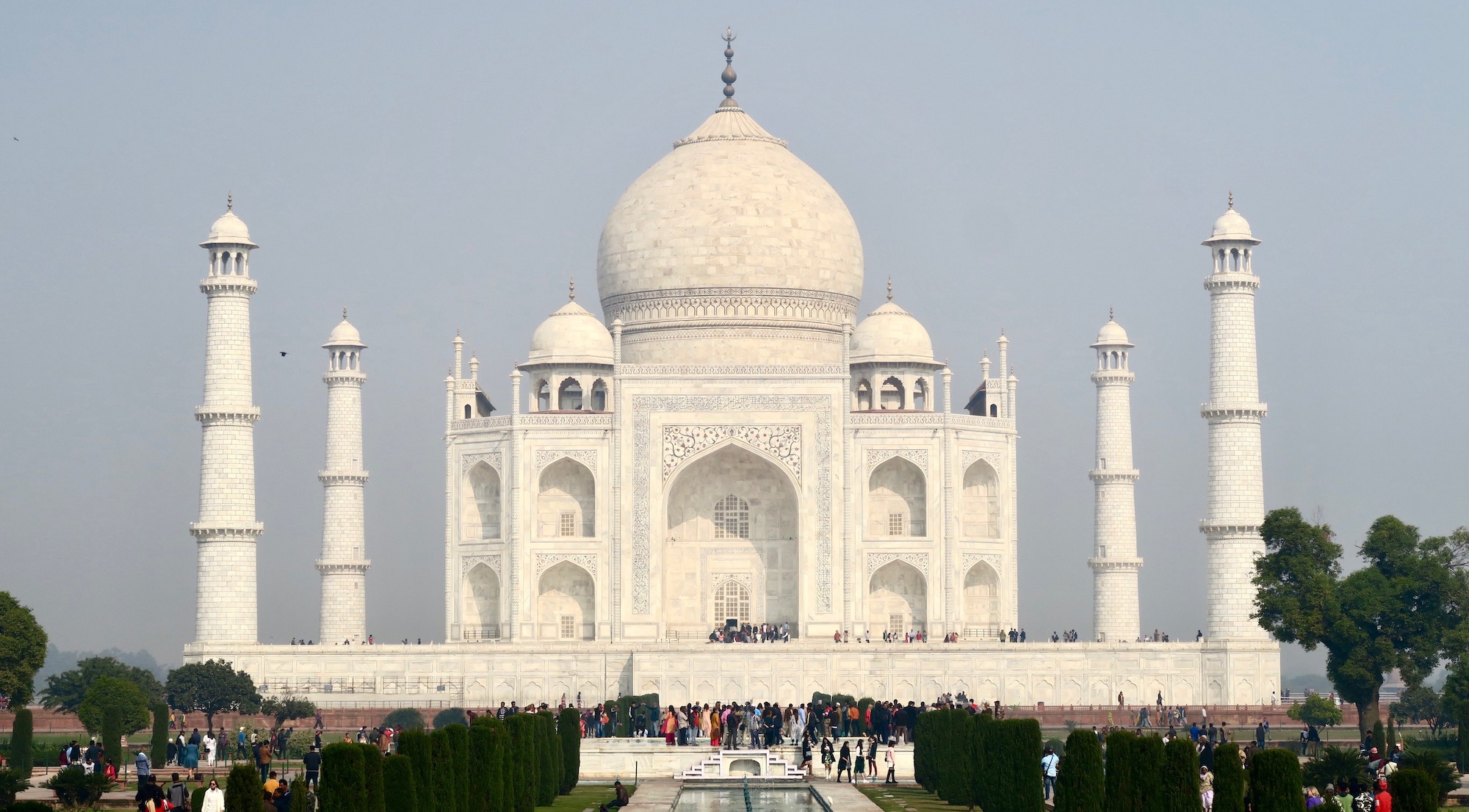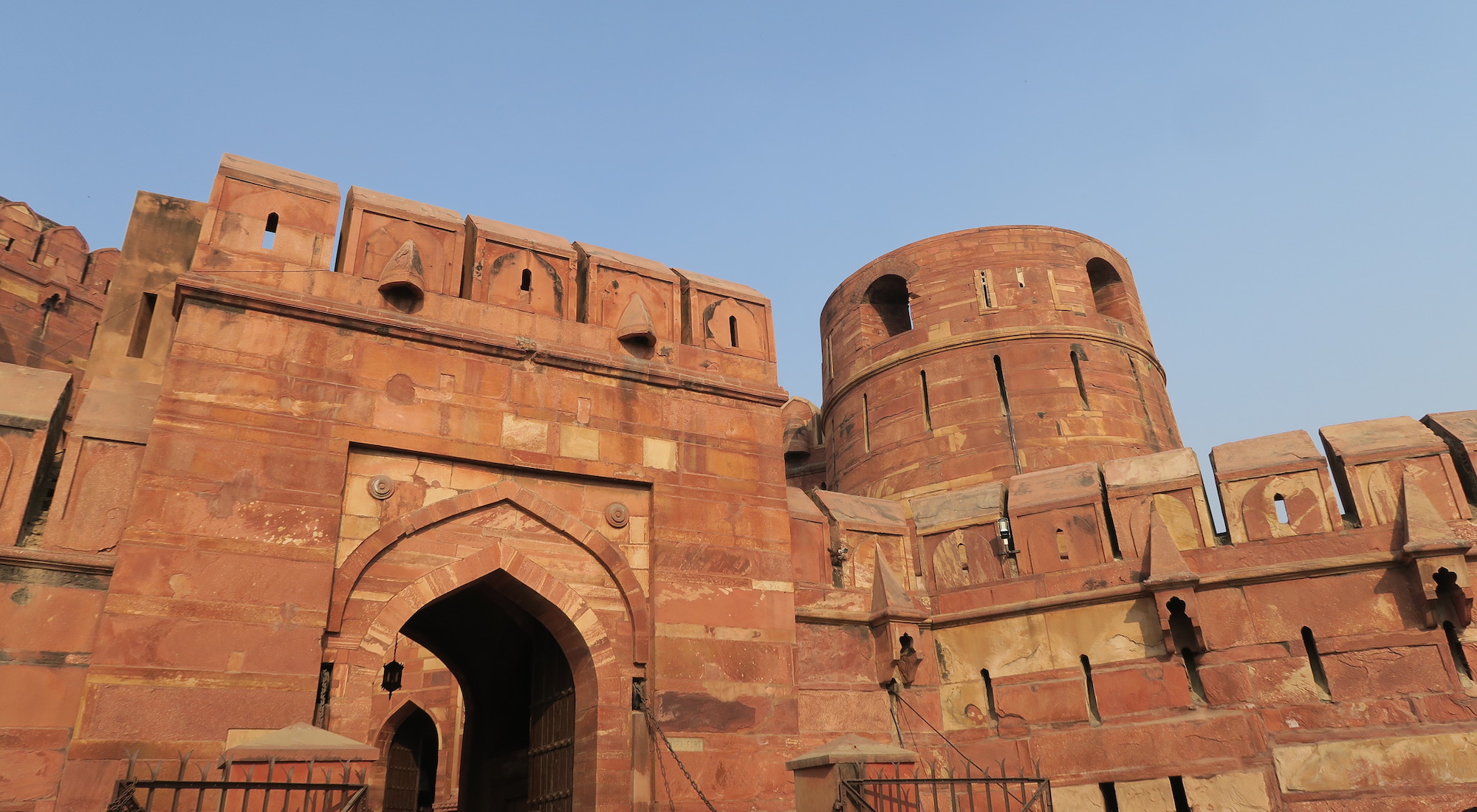I had thought the roads in Mumbai were bad. The streets of Agra are less developed than Mumbai, and much less than Delhi. The current capital had the smooth, well-maintained roads befitting the nation’s capital of one of the world’s nuclear powers. The streets of the old Mughal capital of Agra were more reminiscent of a developing nation — an irony considering the Mughal empire was known for its amazing infrastructure. The (busy, of course) streets were lined with huts, piles of bricks and garbage strewn about. Holy bulls moved nonchalantly through traffic from garbage pile to garbage pile to feed.
It took about three hours to get to Agra from Delhi. I had flown into Delhi from Mumbai the night before on a late flight and stayed in the nicest hotel I have ever stayed at in my life. But it was very late and I could not enjoy the amenities since I had to be up at 6:30am to drive to Agra to see the Taj Mahal. People in Mumbai told me that the road would be nice since it was a new highway, and it was. Although it took an hour of driving through dense fog to get out of Delhi, once we got on the highway it was smooth sailing.

The highway was surprisingly empty. Not only was there nearly no traffic (which was surprising enough in India!) but the countryside was empty too. For a country with 1.2 billion people I was expecting more density, something more akin to driving between cities in the population corridors of Japan… each city and town just sort of melds into one another with no break. On the road to Agra I stared out of the car window watching endless farmland and tiny villages pass by. Vehicles passed by us as well. Apparently our hired vehicle had a speed inhibitor limiting us to 80kmh, a common thing for commercially licensed passenger vehicles.
The land was flat and green. Rice paddies and mustard seed fields were divided by deserted single lane dirt roads. Occasionally we saw Hindu temple, or a Muslim mausoleum. Every so often there was a roadside stop with a gas station and some food amenities. We stopped at a nice one that was decorated “Chinese” style and had veggie sandwiches and masala chai served in traditional clay cups. I walked around the corner to the washroom and saw that there was a Starbucks… even here in the middle of nowhere.

After a while the verdant fields gave way to the concrete interchange of dusty Agra, the old capital of the Mughals, Islamic conquerers with roots to the Mongol hordes who ruled India from the mid-16th century until being in turn conquered by the British in the mid 19th century. Agra is partially bisected by the Yamuna river, which wends and winds its way through the plain, and whose shores are decorated with spectacular Islamic architectural treasures. Today we would visit the two most famous.
India’s symbol of love: The Taj Mahal
Faisal, our tour guide, met us on the side of a dusty road. A local Muslim, he claimed ancestry to the original builders of the Taj Mahal. He took us to the outer entrance to the Taj Mahal where we got out of our speed-limited SUV and boarded an open air electric bus with some Chinese tourists. It was about a kilometer to the ticket booth. Gas vehicles are not allowed near the Taj Mahal in an attempt to mitigate the impact of pollution, which is slowly discolouring the white marble. We got our tickets (I was charged more for being a non-Muslim foreigner, but I got a complimentary bottle of water which was appreciated!) and walked through the red sandstone of the west gate, wanded by the ever-present and ever-bored security. We were not allowed to take anything but cameras and water.

The forecourt of the Taj is bordered by four sandstone gates. The East and West gates are the main entrances for tourists. The south gate opens to the Worker’s Colony, where the descendants of the original builders of the Taj still lived. They maintained the (secret) skills of construction through the ages and maintained the Taj to this day, while also producing other marble crafts for sale. The north gate, which opens out onto the Taj Mahal gardens is the most impressive. Each of these gates, the walls, and the other buildings in the complex are made of the red sandstone native to the region, while the Taj Mahal itself is made of Makrana marble, a peculiar translucent white marble that is apparently the hardest in the world, and is mined nearly 400 kilometres away. The entire complex including the tomb, the mosque to the left (as you enter the complex) and the guesthouse on the right for dignitaries, took 22 years to complete (and the work of 22,000 labourers). But the white tomb alone took 12 years to complete.

The entire complex is geometrically symmetrical — including all the buildings, gardens and fountains — except for one part. After walking through the north gate and seeing that famous view, you make your way up to the main building, put some paper booties on before mounting the marble stairs and entering through the front. Inside, where photos are prohibited, you can see the tomb of Mumtaz Mahal, the favourite wife of Shah Jahan, the Mughal emperor who commissioned the entire complex as a symbol of love for his wife who died while giving birth to her fourteenth child. High above is a dome within a dome, a neat architectural trick to keep the building cool. In the exact centre of the room rests the small tomb of Mumtaz Mahal, and just beside it to the east in a very non-symmetrical spot, lies the much larger tomb of Shah Jahan himself. When he died 35 years after Mumtaz Mahal, his daughter had him entombed by her side.
The asymmetry of his tomb does not diminish the beauty of this building (and if anything enhanced the symbolism). The handiwork is very impressive. Although I have seen much more elaborate Islamic architecture at mosques in Iran, the inlay work here was amazing, especially considering the hardness of the marble and that huge blocks of it had to be shipped from hundreds of kilometres away in the middle of the 17th century. When exiting out of the back of the main building there is a marble plaza that overlooks the Yamuna river. On the other side of the river, in the shadow cast by the white Taj Mahal, you can see the abandoned foundations for another building that Shah Jahan had commissioned: the Black Taj.
A symbol of power: Agra Fort
Up the river to the west of the Taj lies Agra Fort, the palace of the Mughal emperors. In his old age, Shah Jahan was kept here in a marble room under house arrest by his son. The room had a balcony with a perfect view of the Taj Mahal over the double moat of the fort — one watered and filled with alligators, the other dry and filled with lions and tigers.

The Agra Fort is made with the same sandstone as the outer buildings of the Taj Mahal, but with pieces of non-uniform colour giving it a sort of camouflage look that is appropriate for a military outpost that is now occupied by the Indian Army. Only about 20 percent of the fort is open to visitors. Its asymmetrical look is dissonant after being at the Taj, but it is no less impressive. Built over a period of 92 years, the fort contains a number of palaces, public spaces, and bazaars. It was not only involved in Mughal battles from the 16th to the 18th century, but also in battles with the British in the 19th century.
Even though we only have access to 20%, the Agra Fort complex is filled with many historical sites (and about a million tourists). There are grand plazas open plazas for bazaars, and covered, pillared plazas for petitioning the shah. Everywhere are fountains and meticulously clipped shrubbery and flowers. The remnants of the British can be seen by a cannonball hole in one of the buildings, and more prominently, the tomb of John Russell Colvin who died defending Agra during the Sepoy Uprising.
Our tour guide took us to some tourist-trap rug merchants and the like, and we had lunch in a lovely restaurant where I had a delicious biryani. The streets were dusty and busy with traffic, but not near as bad as Delhi.
It took us nearly 5 hours, almost twice as long, to get back to Delhi. The sunset over the endless rice fields was red and beautiful, hazy with smog rather than fog at this time of day. We stopped at a tiny tea shop on a side road which led to the town where Krishna was born. There was no time for a side trip. I drank down my daily malaria pill with some hot masala chai, and snoozed in the vehicle as it barely moved in the evening commuter traffic, which began far outside of Delhi.
A symbol of modernism: Delhi
On my last day in India I had time in the morning to explore the ITC Maurya Hotel. Back in the seventies, the lavishly wealthy India Tobacco Company decided to diversify. It entered a number of markets like CPG, personal care, stationary, etc. One of verticals ITC heavily invested was hospitality. Now there are over 90 luxury hotels under the ITC brand, including a couple of “Seven” star hotels only for royalty. Unfortunately I had to schlep it in a merely 5-star hotel. However, I can report that the massive bed with metal finishings, lavish drapes, and claw-footed bathtub with the fluffiest towels I have ever seen, was satisfactory.
Delhi is a grand city, with wide boulevards that connect large circular plazas which feature massive statues and/or flower beds. It is a city for impressing foreign dignitaries, but things were extra turned out for Republic Day, a massive celebration to be held a week after I left. After shopping for souvenirs at a government-run store for crafts and Indian goods (no haggling and only “authentic” goods available), we stopped in Connaught Place for an early dinner of Indian Chinese food. CP is a wide circular plaza in the center of the city. The circular Central Park in the middle is surrounded by three circular roads, intersected by eight boulevards that radiate outwards like a hub with spokes. The curved city blocks surrounding the park are two and three-storey buildings in the colonial style. I didn’t get to see much of Delhi, but what what I did see was not that high. Even Mumbai didn’t seem to have the high skyscrapers of cities in other countries. However, the circular 19th century blocks certainly had personality that I have never seen in the globalized, uniform glass and steel buildings of other metropolises.
Either way, the Chinese food was a good transition before leaving India for Hong Kong that evening.
I was in India for a mere 10 days, but it was wildly different than I imagined. I can very much understand how Western people fall in love with the country. Four thousand years of history and the sheer diversity inside the country means endless discovery. There are many, many challenges that India and Indians face, but even I could see with my shallow experience the opportunity! I certainly hope to make it back there again, to visit other regions and be awed by entirely different places, people, and food.

